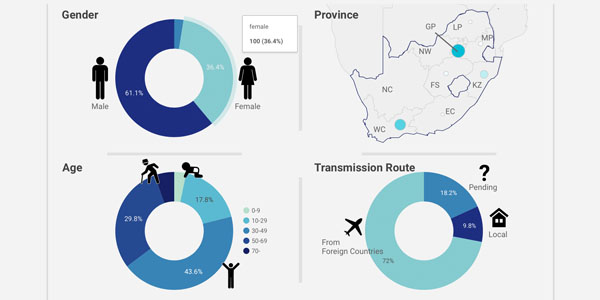Wits COVID-19 dashboard goes continental
- Wits University
New features added as inter disciplinary and inter-institutional collaboration data on the pandemic grows.
Wits University’s COVID-19 South Africa Dashboard has grown with new data features, including snapshot views of how the pandemic is spreading in Africa, as well as statistics showing world trends, being added. (As featured in this article in TIME Magazine.)
The dashboard, launched on 22 March, by Professor Bruce Mellado from the Wits School of Physics and Senior Scientist at iThemba LABS, has gained momentum with a number of volunteers from different disciplines working 24/7 to develop and maintain the dashboard. Wits university is working in collaboration with iThemba LABS of the National Research Foundation.
The visualisation of large quantities of data on the pandemic is a critical step in the analysis of that data. It provides an essential input for analysts to develop the first intuition with which to devise models. The relevance of the visualisation that the dashboard provides is therefore significant.
“The design, development and updating of the dashboard requires a large collaborative effort,” says Professor Barry Dwolatzky, Director of Wits University’s Joburg Centre for Software Engineering (JCSE). “I am assisting in the coordination of the project. Under Bruce Mellado’s leadership a team of highly dedicated and motivated student volunteers, drawn from a variety of disciplines, is working to develop and maintain the dashboard. Although all of us are locked down and working from home, a strong team spirit has developed. I find it interesting that few of us have actually met."
The dashboard is maintained daily and updated within minutes of Government’s announcements on the latest statistics. It provides historical data of relevant parameters, provincial and other breakdowns and it has undergone a number of upgrades since its release.
“Many of the upgrades have been requested by scientists and journalists from all over the country to improve the presentation of the South African data. Currently the site averages about 10 thousand views a day,” says Mellado.
One of the upgrades performed on the dashboard is the addition of a dashboard for the African continent that includes a detailed account of total cases, mortality and recoveries for all African counties. This addition has triggered a collaboration with the Botswana International University of Science and Technology (BIUST) to develop the first COVID-19 dashboard for Botswana, using data from the National Emergency Operation Centre of Botswana.
“This adds a new and important dimension to our existing collaborations with Wits and iThemba LABS,” says Professor Gregory Hillhouse, Head of the Department of Physics and Astronomy at BIUST.
“It is gratifying to see that one of our MSc students who has been trained at iThemba LABS, Mr Otsile Tikologo, is actively involved with this project.”
Another upgrade illustrates the global analysis of the spread in the conditions of containment (or “lockdown”) using epidemiological models. A number of countries have been selected for which containment measures have led to significant reduction in the rate of spread.
Data analysis and statistical treatment of this feature are performed using a frequentist framework. For this purpose the data processing framework ROOT developed by the European Laboratory CERN is used. Results are presented in terms of lower and upper curves for the cumulative number of positive cases as a function of time. These are estimated on the basis of a 68% confidence level. Predictions are updated on a daily basis.
“Understanding the impact of containment measures on the spread of the virus is essential to managing this crisis. Global data provide an invaluable insight into the dynamics of this complex problem,” says Mellado.
Links
- Wits’ COVID-19 South Africa Dashboard: https://www.covid19sa.org/
- iThemba Labs: https://tlabs.ac.za

